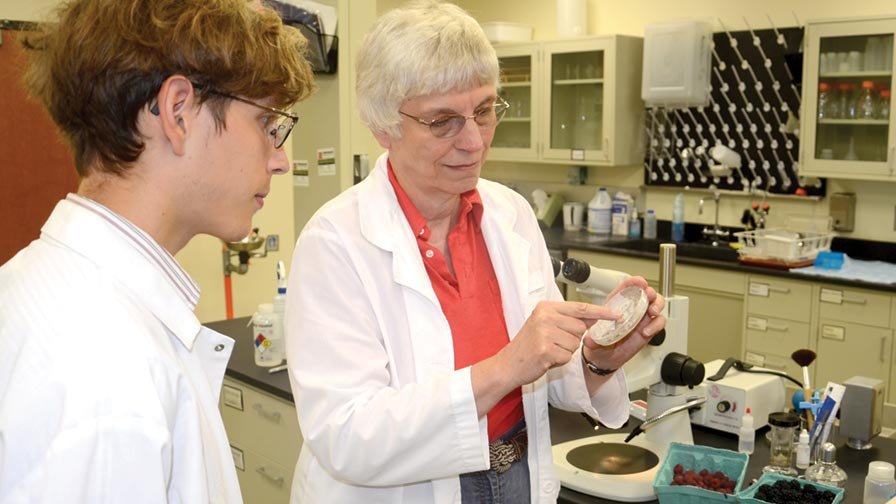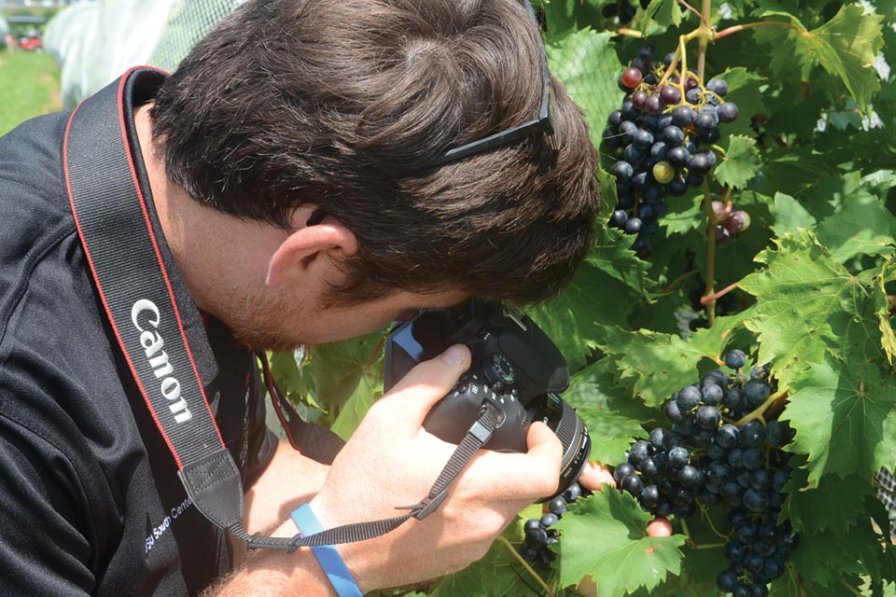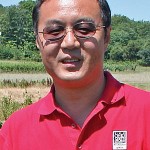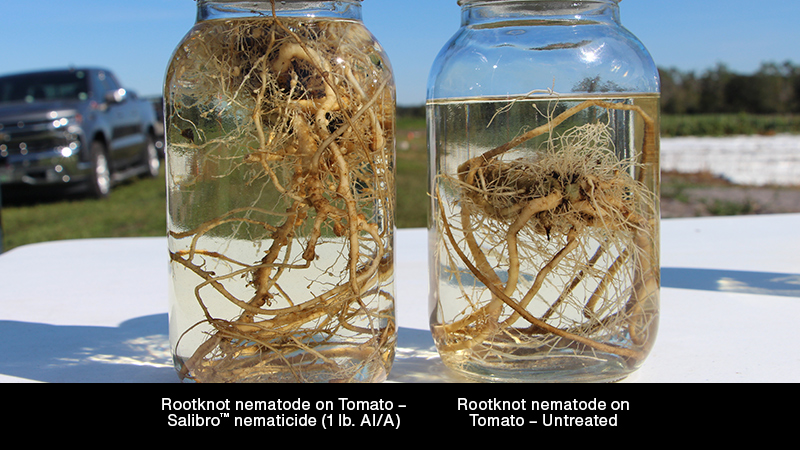Pest And Disease Diagnosis 101 In Berries
Diagnosing problems correctly and efficiently in berry patches may sound more like “It is not what you know, but who you know.”
We all have heard of the phrase. The same principle can be true in diagnosing cultural, disease or pest problems in berry production. Berry growers can encounter many problems in their daily routine. Some problems are relatively straightforward while others may be much more difficult. These “strange” problems may take what growers know and whom they know. Here are a few pointers to make your life a little easier.
Know the Experts

Nancy Taylor, the director of C. Wayne Ellett Plant and Pest Diagnostic Clinic of The Ohio State University, demonstrates the characteristics of fungal culture of Phomopsis twig blight of blueberries to Jacob Scharfetter, a college intern from Kenyon College in Ohio. (Photo credit: Gary Gao)
Getting to know the experts in your state is probably the most important step in correctly diagnosing problems. I’d start with your local, regional, or state Extension specialists. For example, Dr. John Strang is an Extension specialist with the University of Kentucky for fruit and vegetable crops. Dr. Celeste Welty of The Ohio State University is our state entomologist for fruit crops and many vegetable crops. People like Dr. Strang and Dr. Welty can quickly identify the problem for you or point you in the right direction.
I would also get to know some key fruit researchers in your area. Dr. Annemiek Schilder of Michigan State University is an expert on diseases of small fruit crops, mycology, and integrated disease management. Patrick Byers of the University of Missouri knows everything there is to know about elderberries. Dr. Bruce Bordelon of Purdue University is an expert on grapes and small fruit for Indiana.
In Ohio, I am a small fruit specialist. I have been working on aronia, blackberries, blueberries, elderberries, goji berries, raspberries, and winegrapes. I know a little bit about a few things. Well, kind of like “a mile wide and an inch deep.”
Know a Good Diagnostic Lab
Getting to know the diagnostic lab(s) in your area can be very helpful too.
“Plant disease management usually requires planning and preparation for prevention of plant diseases,” says Nancy Taylor, the director of the C. Wayne Ellett Plant and Pest Diagnostic Clinic at The Ohio State University (http://ppdc.osu.edu/).
Readers can find their local plant disease diagnostic laboratory by visiting the National Plant Diagnostic Network website NPDN.org and scroll down to find their state’s laboratory. Many of these labs, if not all, are a for-fee-service. Their fees, I might add, are very reasonable for what they do and what you can get. I would encourage growers to consider submitting samples to these labs when they need answers. Sometimes, this is about the only way to find out the root cause(s) of the problem.

Taking high quality photos and emailing them to experts can be an effective way to help diagnose disease problems. Ryan Slaughter, a research assistant at OSU South Centers, is shown here taking close-up pictures of grape disease problems. (Photo credit: Gary Gao)
Know How to Take Good Pictures:
When you encounter some strange problems, it is helpful to take a few good pictures. If you are a decent photographer and have a suitable camera, take a few close-up photos in addition to overall whole-plant shots. Since travel funds for university folks are limited, if they have any at all, digital diagnosing is a cost-effective tool. We have all heard of the saying “a picture is worth a thousand words.” Well, I would add “good” before “picture.”
Folks like me have received many blurry cell phone pictures. Pictures of poor quality are really not worth much. It is equally critical to take pictures of the correct parts too. This is why it is important to send a few photos. Sometimes, we might ask growers to go back to get more.
Know the Good References:
References are certainly very handy tools. I still like hard copies of pest and disease diagnostic guides. The American Phytopathological Society (APS) has published quite a few compendiums of diseases and sometimes pests that are available at the APS Bookstore. A newly revised “Compendium of Blueberry, Cranberry, and Lingonberry Diseases and Pests, Second Edition, Edited by James J. Polashock, Frank L. Caruso, Anne L. Averill, and Annemiek C. Schilder” is an excellent example.
This guide has more than 400 images to help growers with diagnosing diseases and insects in blueberries, cranberries, and lingonberries. Even though this reference is quite pricy, it is still a great investment.
Do I sound like a life insurance salesman now? A less expensive and highly useful alternative is “A Pocket Guide to IPM Scouting in Highbush Blueberries (E2928)” by Annemiek Schilder and Rufus Isaacs of Michigan State University.
Many books area available in various electronic forms. The eBooks or iBooks are quite affordable.
Know the Good Website(s)
There are a few good websites for diagnosing fruit problems. One example is the Cornell Fruit — Berry Diagnostic Tool by Drs. Marvin Pritts (Cornell University), Gina Fernandez (NC State), and Kim Hummer (USDA) at Fruit.Cornell.edu/BerryTool. There are a lot of nice pictures on this website, which was developed by some of the top scientists in the field. This tool is free. Can’t beat that with a stick! Check it out and let me what you think.
Diagnosing problems in the berry patch can be a challenging and time-consuming task. Getting to know the right experts, right diagnostic lab, the right pictures to take, and right references and web tools can be a “life saver” for everyone.










